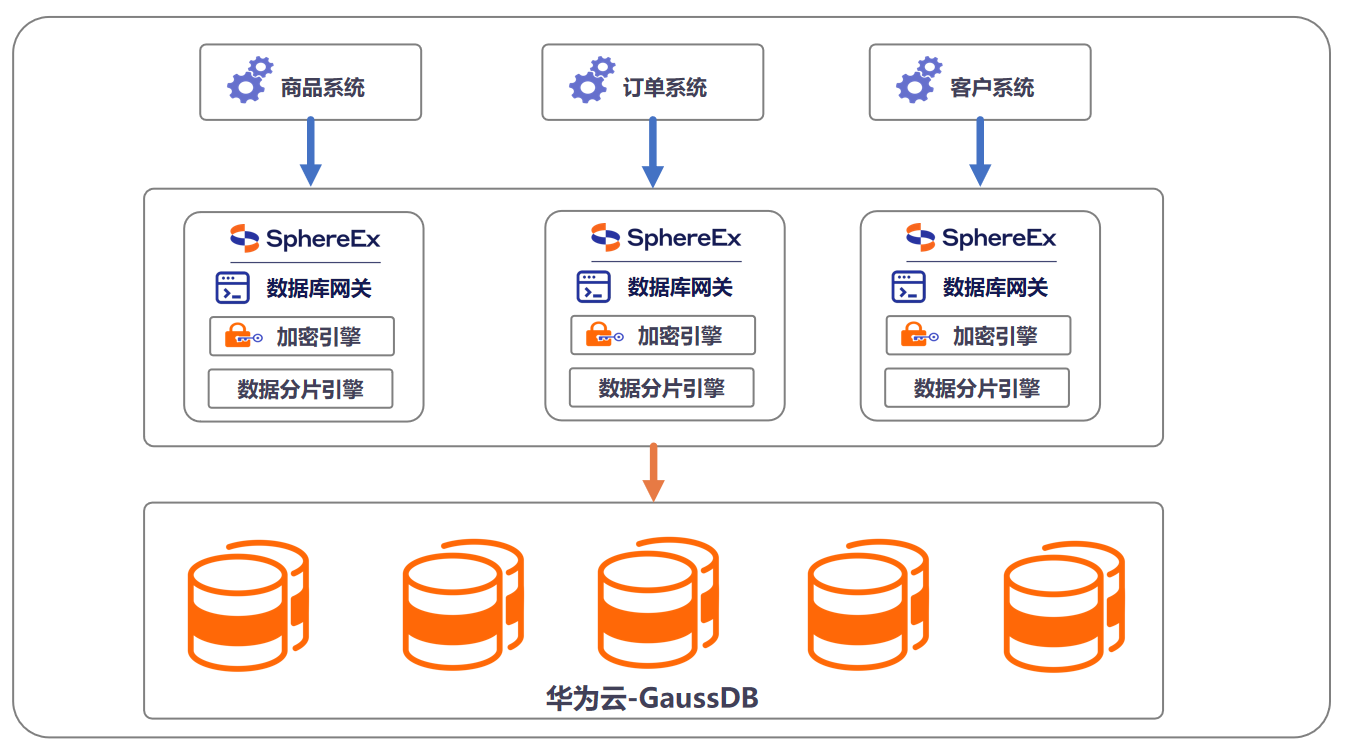客户介绍
客户介绍:
【某知名服装B2B电商平台】作为国内服装批发领域的领先B2B电商平台,致力于为实体服装店主、二级批发商提供一站式采购服务。平台深度整合全国一级批发市场资源,首创“一件起批、打包价”模式,有效降低了中小商家的库存成本与经营风险。随着业务规模持续扩大,平台日均处理数千款新品上架与海量订单交易,其核心电商服务平台已成为连接上游数万家供应商与下游数百万服装店主的关键枢纽。
应用介绍:
应用名称:电商服务平台
应用说明:平台连接上游数万家供应商与下游数百万服装店主。每日处理海量订单与商品数据流,同时大数据分析智能驱动选款与供应链决策,显著提升行业供需匹配与流通效率。
业务挑战
客户需求:
随着平台业务量的指数级增长,其底层数据库架构面临严峻挑战,主要集中在性能与安全两大维度:一是海量数据处理压力,传统IT架构在订单高峰期的计算、存储及扩展性方面遭遇性能瓶颈,难以支撑高并发实时需求;二是数据安全与合规风险,订单中涉及的客户地址、电话等敏感信息面临泄露威胁,需构建严密防护体系以满足《网络安全法》《个人信息保护法》等法规要求。
核心痛点:
- 性能瓶颈痛点: 单一数据库实例已无法承载10亿级别的数据量与高并发访问,导致查询速度慢、接口超时,系统扩展性差,制约了业务的快速发展。
- 安全合规痛点: 明文存储敏感数据存在极高的泄露风险。若采用应用层加密方案,则需要对现有业务代码进行大规模、高成本的改造,且难以保证全局一致的安全性,合规改造成本高昂。
- 技术债务痛点: 平台采用Java/Golang/Python等多语言技术栈,任何底层数据架构的调整都可能需要多个技术团队协同改造,技术复杂度高,实施风险大
解决方案
方案概述:
SphereEx为电商平台提供了一站式数据层增强解决方案。该方案在电商平台应用与底层华为云GaussDB数据库之间,部署了透明化的数据库网关。该网关内置了高性能数据分片引擎和无缝数据加密引擎。通过数据分片功能,将单一巨表按规则分布到多个数据库节点中,实现了数据的水平切分与负载均衡,彻底解决了性能瓶颈。通过数据加密功能,对写入数据库的敏感字段进行自动、透明的加密,从底层保障数据安全。整个方案对业务应用完全透明,无需修改任何业务代码,以零侵入的方式,同时满足了平台对海量数据的高性能处理与严格的数据安全合规要求。
架构图:

方案亮点
- 透明化数据分片,破解扩展难题: 通过内置分片引擎,将大数量单表自动分布到多个数据库节点,实现线性水平扩展,轻松应对高并发流量,查询性能提升显著。
- 内置数据加密,实现安全合规零改造: 提供字段级别的透明加密能力,对敏感数据自动进行加密存储和解密查询。业务应用无需任何代码修改,即可达到国家法律法规的合规要求,极大降低了实施成本和风险。
- 协议级抽象,屏蔽技术栈差异: 数据库网关支持标准数据库协议(如MySQL/PG),完美兼容Java、Golang、Python等多种开发语言,对异构技术栈的应用系统提供统一、安全、高效的数据访问入口。
客户收益
核心成果:
- 性能提升: 数据库层面成功支撑了10亿+ 数据量的存储与访问,高峰期核心接口响应时间降低超过70%,系统稳定性达到99.999%。
- 扩展性增强: 实现了数据库的线性水平扩展,未来业务增长可随时通过增加分片节点应对,扩容过程对业务零停机。
- 安全达标: 核心敏感数据实现100% 加密存储,顺利通过内部安全审计与外部合规检查,为平台奠定了坚实的安全基石。
战略价值:
- 技术赋能业务: 稳定、高效的数据层为业务创新(如实时推荐、大数据分析)提供了坚实底座,助力平台巩固并扩大市场领先优势。
- 降低总体拥有成本: 通过“零代码改造”方案,节省了大量的研发投入、测试周期和潜在的业务中断风险,投资回报率显著。
- 提升品牌信任度: 构建了业界领先的数据安全防护能力,增强了供应商与采购商对平台的信任感,提升了品牌形象与核心竞争力。
